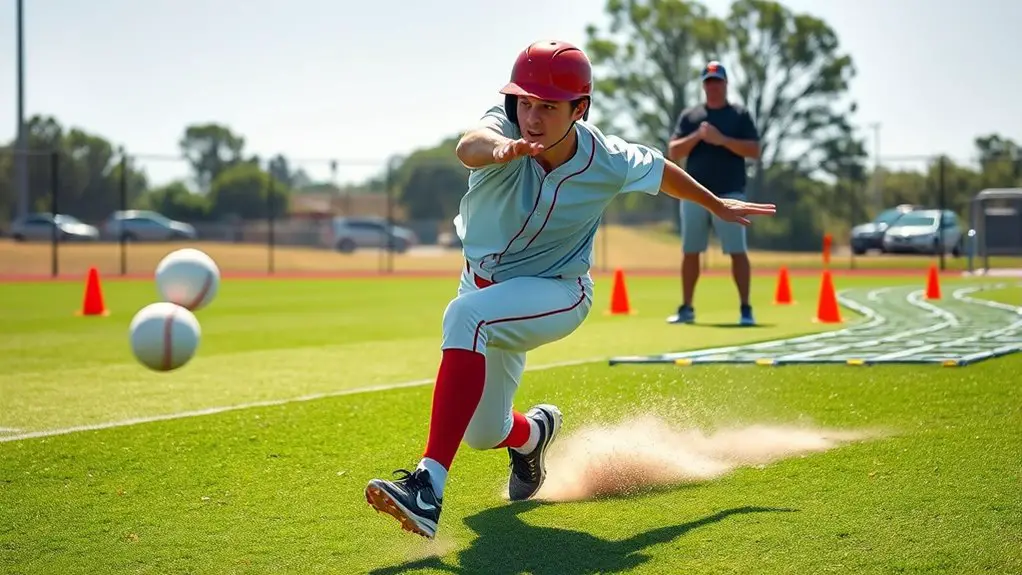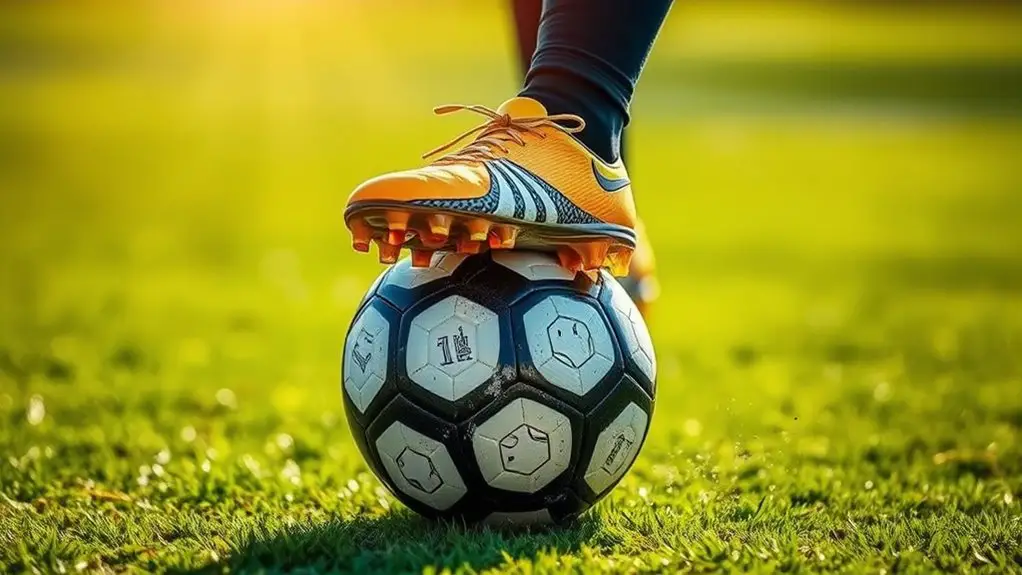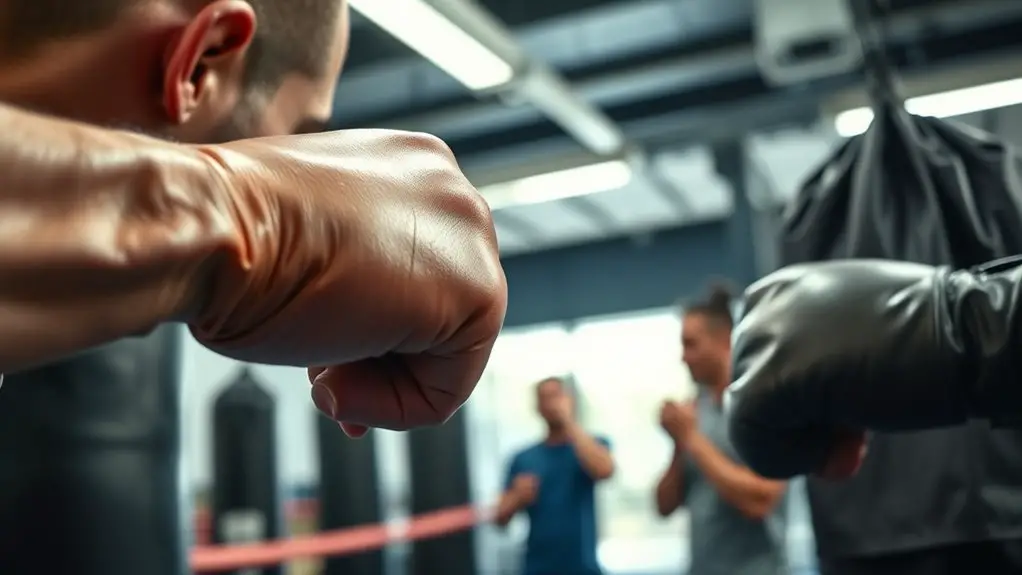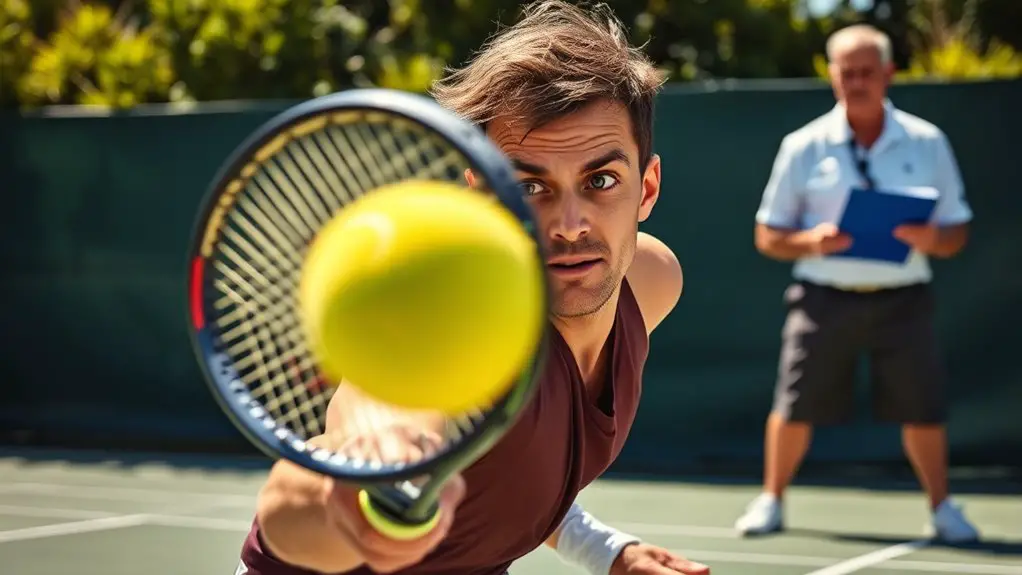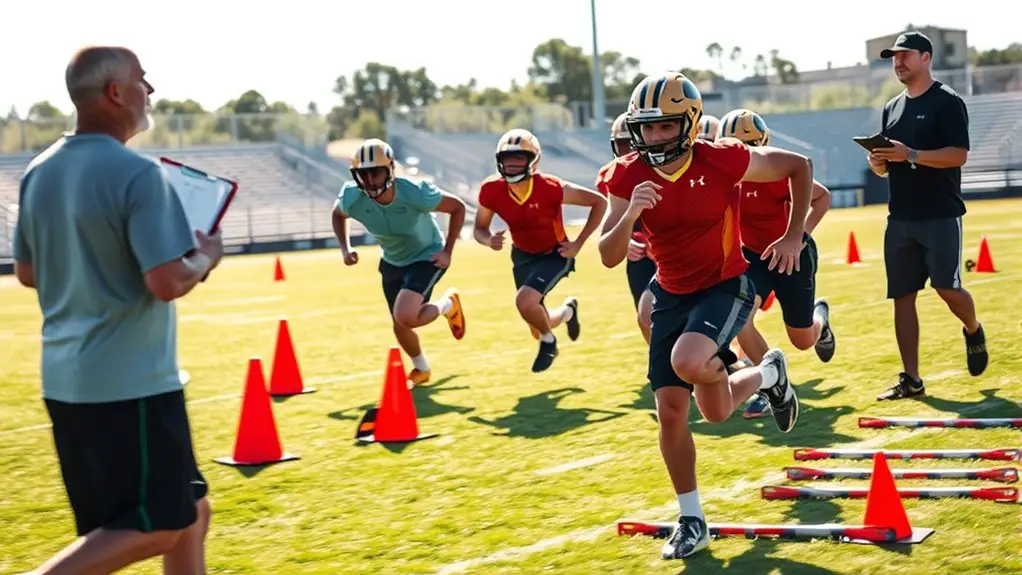To boost your fielding reflexes, focus on drills like reaction ball exercises and partner tosses. These improve hand-eye coordination and quick decision-making. Incorporate cone agility drills for foot speed and shadow fielding to refine technique. Ball drop reaction drills enhance your timing and anticipation. Don't forget eye-hand coordination exercises for a well-rounded approach. By consistently practicing these techniques, you'll see significant improvements on the field. Explore additional methods to take your training to the next level.
Importance of Quick Reflexes in Fielding
When you're out in the field, quick reflexes can make all the difference between a game-winning play and a missed opportunity. To master fielding fundamentals, you need to sharpen your instincts. Speed isn't just about physical ability; it's also about mental preparation. You've got to anticipate where the ball might go, reading the game and reacting in an instant.
Developing quick reflexes means being fully in tune with your surroundings. It's not just about catching; it's about positioning yourself to make that essential play. The more you engage with the game, the sharper your instincts become. Practicing mindfulness improves awareness of cues during competition, allowing you to react more effectively. Practice makes perfect, and with every drill, you're training your mind and body to respond faster.
Reaction Ball Drills
Reaction ball drills are a fantastic way to sharpen your reflexes and improve your fielding skills. These unique balls bounce unpredictably, forcing you to react quickly and develop better hand-eye coordination. By incorporating effective training techniques with reaction balls, you'll elevate your performance on the field. Additionally, practicing these drills can help enhance mental clarity which allows for swift reactions and better decision-making during games.
Benefits of Reaction Balls
While many drills focus on improving speed and agility, incorporating reaction balls into your training can greatly boost your reflexes. These unique tools provide essential reaction ball benefits, enhancing your hand-eye coordination and quickness. Using reaction balls helps you develop agility improvement, allowing you to respond to unpredictable plays during a game.
| Benefit | Description |
|---|---|
| Hand-Eye Coordination | Improves your ability to track and catch |
| Quick Reflexes | Sharpens your response time in the field |
| Fun Training | Adds variety to your drills, keeping you engaged |
Integrating reaction balls into your routine not only makes training enjoyable but also empowers you to perform with greater confidence and freedom. Embrace the challenge!
Effective Training Techniques
Incorporating reaction balls into your training can greatly enhance your reflexes, but it's important to implement effective techniques to maximize their benefits. Focus on sharpening your visual focus and mental agility through these drills:
- Vary the bounce: Use different surfaces to keep your mind and body on their toes.
- Partner drills: Work with a teammate to throw the ball at unpredictable angles, forcing you to react quickly.
- Timed challenges: Set a timer and see how many catches you can make in a minute to boost your intensity.
These techniques will not only improve your reflexes but also ignite your passion for the game. Embrace the freedom that comes with enhanced skills, and you'll find yourself playing with unmatched confidence.
Partner Toss Drill
One of the most effective ways to enhance your reflexes in fielding is through the Partner Toss Drill. This drill not only boosts your hand-eye coordination but also hones your partner communication skills. You and your partner can stand a few feet apart, tossing the ball back and forth. Focus on toss accuracy; aim for each other's gloves to encourage quick reactions.
As the drill progresses, increase the speed and vary the height of the tosses. This variation keeps you on your toes and forces you to adapt swiftly to different situations. Remember, it's about more than just catching; it's about anticipating where the ball will go and reacting in real time. Incorporating agility drills into your routine can further enhance your overall reflexes and responsiveness.
Cone Agility Drills
To improve your reflexes and agility on the field, Cone Agility Drills are an excellent choice. These drills not only enhance your speed but also give you the freedom to maneuver effortlessly. With the right cone placement, you can focus on sharp turns and quick reactions, essential for fielding.
Here are some emotions you'll experience while practicing:
- Excitement: Feel the thrill as you navigate through the cones.
- Empowerment: Gain confidence in your ability to react swiftly.
- Connection: Experience a deeper bond with the game as your skills develop.
Set up your agility cones in various patterns, challenge yourself to improve with each session, and feel the rush of mastering your movements. You'll notice how your reflexes sharpen, allowing you to respond instantly to every play. Additionally, incorporating lateral movement techniques can significantly enhance your response time during drills. Embrace the challenge and watch your game elevate!
Shadow Fielding
Shadow fielding is a fantastic way to improve your technique and enhance your reaction time without needing a ball. By practicing your movements and positioning, you'll develop muscle memory that translates into real game situations. This drill lets you focus on your form and speed, ensuring you're always ready for whatever comes your way. Additionally, incorporating agility ladder drills into your training can further boost your foot speed and coordination.
Technique Improvement
Improving your technique through shadow fielding can greatly enhance your reflexes on the field. By focusing on your movements without the pressure of a game, you can engage in technique analysis and realize significant skill enhancement.
- Feel the freedom to express your natural athleticism.
- Embrace the opportunity to visualize perfect plays.
- Discover the joy of mastering your body's movements.
As you practice, be mindful of your posture, footwork, and hand positioning. These elements are essential in developing a fluid, instinctive playing style. With each session, you'll build confidence and precision, allowing you to react effortlessly when it counts. Shadow fielding isn't just practice; it's a way to reveal your potential and elevate your game!
Reaction Time Enhancement
Building on your technique through shadow fielding, enhancing your reaction time can greatly impact your performance. This drill allows you to practice without the pressure of a game, letting you focus on your visual perception and cognitive processing. Picture yourself in a game scenario; visualize the ball coming toward you while you react as if it's real. By simulating various plays, you'll train your brain to process information faster, sharpening your reflexes. Remember, it's not just about physical speed—your mind needs to keep up. Incorporate shadow fielding into your routine, and you'll find your ability to anticipate and respond will improve dramatically, giving you the freedom to excel in the field.
Ball Drop Reaction Drill
While practicing your reflexes is essential for effective fielding, the Ball Drop Reaction Drill stands out as a highly effective method to sharpen your reaction time. This drill not only hones your agility but also brings a thrilling edge to your training. Here's how it works: a partner drops a ball, and you react, catching it before it hits the ground.
Why's this drill crucial?
- It challenges your quick thinking and response.
- You'll feel the rush of adrenaline as you race against time.
- It builds confidence, making you more fearless on the field.
- This drill also emphasizes proper footwork, which reduces the risk of sprains and strains.
With each ball drop, you'll enhance your reaction timing and elevate your game. Embrace the freedom to move swiftly and decisively, and you'll see the results translate into your performance. So, gear up, and let your instincts take flight!
Eye-Hand Coordination Exercises
After mastering the Ball Drop Reaction Drill, it's time to take your skills to the next level with Eye-Hand Coordination Exercises. These drills enhance your ability to track and respond to fast-moving objects, giving you an edge on the field. Start by practicing eye tracking with a partner tossing balls at different angles. Focus on keeping your visual focus sharp as you catch or deflect each throw.
Another great exercise is the juggling drill. Juggling not only improves your hand-eye coordination but also strengthens your reaction time. Try to gradually increase the number of balls to challenge yourself. Additionally, incorporating glute activation exercises into your routine can enhance your overall athletic performance, supporting quicker movements and improved stability.
Incorporating these exercises into your routine lets you feel more in control during play. You'll find that your reflexes improve markedly, allowing you to make quicker and more accurate decisions in the field. Embrace the freedom that comes with mastering your coordination, and watch your game elevate!
Daily Reflex Training Routine
Establishing a consistent daily reflex training routine is essential for enhancing your fielding skills. This routine not only sharpens your reflexes but also empowers you to feel confident and free on the field. Here's how to build a routine that works for you:
A consistent daily reflex training routine boosts fielding skills, enhancing confidence and agility on the field.
- Incorporate daily flexibility exercises to improve your range of motion and prevent injuries.
- Use mental focus techniques, like visualization, to prepare your mind for quick decision-making.
- Practice quick reaction drills that challenge your reflexes and adaptability.
Additionally, remember that proper nutrition plays a crucial role in boosting cognitive performance, ensuring that your mind is sharp and ready for action on the field.
Frequently Asked Questions
How Often Should I Practice These Reflex Drills?
You should aim to incorporate reflex drills into your daily routine for best results. Practicing these drills three to four times a week is ideal, but it's essential to listen to your body and adjust your practice frequency accordingly. Consistency is key, but don't forget to mix in some fun activities to keep your passion alive. Balance is important; you want to improve without feeling overwhelmed. Enjoy the process and watch your skills grow!
Can I Do These Drills Indoors?
Absolutely, you can do these drills indoors! With a few indoor adaptations, you can create an effective training space. Consider using soft balls or tennis balls to minimize damage and maximize safety. You might also want to invest in lightweight equipment options like rebounders or agility ladders. This way, you'll have the freedom to practice whenever you want, regardless of the weather outside. Just get creative and make the most of your indoor environment!
What Age Is Appropriate for Starting Reflex Training?
When you're considering age recommendations for starting reflex training, it's best to begin around age 8 or 9. At this age, kids can grasp basic concepts and develop coordination. However, it's important to focus on fun and engaging activities to keep their interest. Everyone's different, so if your child shows enthusiasm earlier, don't hesitate to start! The key is to foster a love for the game while building those essential reflex skills.
Are There Any Specific Warm-Up Exercises Recommended?
Warm-up exercises are your secret weapon! You can't just jump into action without prepping those muscles, right? Dynamic stretching is essential to get your body moving like a rubber band, while agility ladders can have you dancing around like a pro. These exercises not only increase your flexibility but also boost your coordination. So, before you hit the field, make sure you're warmed up and ready to release your full potential!
How Do I Track My Progress in Reflex Training?
To track your progress in reflex training, start by setting specific performance metrics. Keep a journal or use an app to log your reaction times and accuracy during drills. Regularly evaluate your progress by comparing your latest results with past ones. This way, you can see how far you've come and make adjustments if needed. Celebrate your improvements; it's all about enjoying the journey and finding your rhythm while you train!
